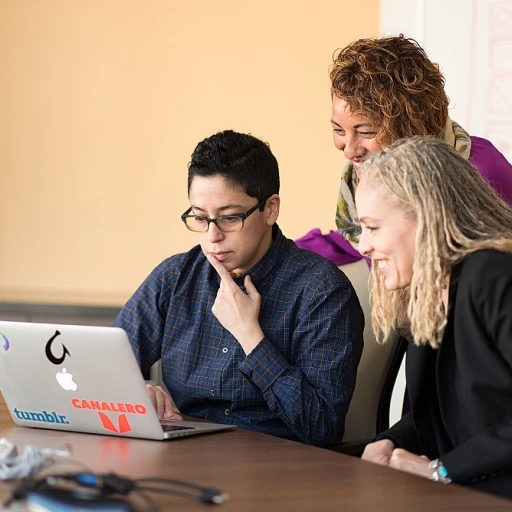Understanding the Essence of Inclusion in HR
Embracing Diversity for a Stronger Workplace Culture
The essence of inclusion in human resources lies in deliberately fostering an environment where diversity, equity, and inclusion (DEI) are not just prioritized but seamlessly integrated into the workplace fabric. This integration involves recognizing the unique contributions of each individual and creating a sense of belonging that empowers employees to bring their full selves to work, which ultimately enhances workplace culture.
Many leading organizations, under the guidance of the Society for Human Resource Management (SHRM), are rethinking traditional HR practices to become more inclusive. These efforts often go beyond simply meeting DEI metrics, aiming instead to embed inclusivity into every aspect of resource management. From recruitment strategies to career progression plans, the goal is a holistic approach that addresses the diverse needs and aspirations of all employees.
Events like the SHRM Inclusion Conference play a pivotal role in propelling these ideals forward by offering a platform for HR professionals to exchange insights and strategies on creating inclusive workplaces. Such conferences also provide opportunities for members to join discussions on pressing issues concerning diversity equity and inclusion, backed by insights from experts and sponsors dedicated to fostering inclusive work environments.
The inclusive workplace not only cultivates fairness and equal opportunities but also harnesses the power of diverse perspectives to drive innovation and creativity. The path toward becoming more inclusive is undoubtedly challenging, but by actively participating in DEI initiatives, organizations can work towards creating environments that celebrate individual differences and enable all employees to thrive.
For HR leaders and professionals seeking to enhance their framework, understanding how to effectively integrate inclusive strategies is critical. From specific behaviors that support belonging to leveraging initiatives like those inspired by the SHRM Foundation, the journey towards true inclusion is continuous and multifaceted. To discover more about how employer branding plays a role in attracting diverse talent, explore this resource on employer branding.
Current Trends in Inclusive HR Practices
Inclusive HR Practices: Trends and Timeliness
Developing an inclusive workplace remains at the forefront for many organizations aiming to enhance their workplace culture. The current trends in inclusive HR practices are driven by a combination of diversity, equity, and inclusion (DEI) initiatives, focused on integrating a sense of belonging among all members of a workplace.
Organizations are increasingly recognizing the strategic value of fostering diversity and inclusion (I&D) within their teams. Attendance at the inclusion conference and other professional events hosted by relevant bodies such as the Society for Human Resource Management (SHRM) plays a crucial role in shaping these practices.
Adopting inclusive practices is not just about setting policies; it also highlights the necessity to address specific behaviors within the organization that may hinder a culture of inclusivity. Here’s a snapshot of some current trends enhancing the inclusive workplace experience:
- DEI Frameworks: Emphasizing comprehensive DEI frameworks that align with the organization's goals and values.
- Novel Employee Resource Groups (ERGs): Facilitating the development of ERGs that support a diverse range of communities, including those related to race, gender, and career stages (innovations in human resources).
- Annual Conferences and Awards: Engaging in society-sponsored events and conferences to honor inclusive practices, such as SHRM's annual gatherings.
- Leadership Training: Providing leaders with skills to champion inclusion and equity across all levels of the organization.
- Technology Utilization: Integrating technology that supports inclusive recruitment and retention strategies.
These evolving practices reflect a shift toward a more inclusive organizational mindset, underpinned by strategic sponsorships and resource allocations. By exploring these trends, organizations are better prepared to join the forefront of inclusive innovation in human resources, ensuring a brighter future centered on diversity, equity, and belonging.
Technology's Role in Driving Inclusion
Making Technology a Catalyst for an Inclusive Environment
In today's rapidly evolving workplace culture, the role of technology in promoting inclusion, diversity, equity, and belonging cannot be overstated. Technology has significantly transformed how organizations approach inclusive innovations, shifting from traditional practices to more nuanced and sophisticated methods.
Advancements in human resource management technology have enabled organizations to design more inclusive workplaces. Tools that provide real-time data and insights help identify areas needing improvement in diversity and equity. This technological aid allows HR professionals to tailor strategies to foster a sense of belonging and inclusion across all workforce levels.
Discussion at venues like SHRM's annual inclusion conference highlights how leveraging tech-driven solutions can reduce biases, particularly in recruitment and performance evaluations. Artificial intelligence and machine learning tools are increasingly being used to analyze specific behaviors, ensuring fair and unbiased recruitment processes. These innovations not only streamline operations but also align with broader DEI goals.
Moreover, platforms dedicated to promoting diversity and inclusion, such as those showcased at various SHRM events and conferences, provide members with programs and resources to support underrepresented groups. These forums also create a network where HR leaders can exchange ideas and strategies, tackle challenges collectively, and acknowledge organizations paving the way in DEI through awards and recognition.
Inclusion diversity targets can be effectively met by harnessing the power of technology, which can shape workplace culture by actively embodying the principles of equity and inclusion. Technology, when properly harnessed, becomes the linchpin that aligns human resource strategies with broader organizational goals focused on creating inclusive workplaces.
As companies continue to grow in diversity and as organizations like SHRM and its state councils play pivotal roles in advancing human resource disciplines, the blend of technology and DEI initiatives will likely remain a focus. By embracing the potential of tech in building inclusive strategies, organizations can ensure a more equitable and inclusive future for all employees.
Case Studies: Successful Inclusion Strategies
Showcasing Achievements in Inclusion
In recent years, the human resources field has seen an inspiring number of success stories that emphasize the power of inclusive practices. HR professionals and organizations dedicate efforts towards fostering an environment where all employees feel a sense of belonging, which has been highlighted in various conferences and events.
For instance, many organizations have pivoted their focus towards diversity, equity, and inclusion (DEI) strategies, as evidenced by the annual SHRM inclusion conference. This event brings together industry leaders to discuss and showcase how specific behaviors and strategies can create a more equitable workplace culture. Participants often discuss initiatives that not only increase diversity but also promote equity and inclusion, successfully demonstrating how workplaces can become more inclusive and welcoming.
Several case studies reveal that organizations achieved notable success by integrating inclusive practices into their core values. Companies recognized at DEI award ceremonies often highlight that inclusivity can lead to enhanced employee satisfaction and overall organizational performance. At these events, the day-to-day work of resource management professionals is celebrated, showcasing that inclusivity is essential in harnessing the full potential of a diverse workforce.
Furthermore, SHRM state councils emphasize cross-collaborative efforts as vital for forging pathways to inclusivity. They encourage HR experts to join forces, share resources, and learn from each other’s endeavors to build a culture where everyone can thrive. By forming college relations and working closely with the SHRM Foundation, companies are developing robust partnerships that prioritize a diverse pipeline of talent.
In conclusion, the collaborative efforts seen across the HR community, as noted at inclusion conferences and in shared best practices, evidence the innovative strides toward inclusivity in the workplace. As HR professionals continue to learn and grow from these successful strategies, the journey towards an equitable future remains a pivotal area for ongoing development and scrutiny.
Challenges and Barriers to Inclusive Innovation
Overcoming Hurdles in Inclusive HR Innovations
Implementing inclusive practices within human resource management is a multi-layered journey. While the benefits of nurturing a culture of diversity, equity, and inclusion are well-documented, several challenges can impede progress in this area. Organizations often confront barriers that require both strategic foresight and practical solutions. Addressing these challenges is crucial for any enterprise aiming to foster an equitable workplace environment.
One significant barrier is the lack of understanding or resistance to change within the workplace culture. Employees or management who are set in traditional ways may perceive DEI initiatives as unnecessary or disruptive. This resistance can lead to a superficial commitment to inclusion, rather than fostering genuine belonging. Integrating SHRM's tools, such as training on specific behaviors that support an inclusive workplace, can be pivotal in overcoming these societal and organizational biases.
Resource constraints also play a crucial role. Smaller organizations or those with limited budgets may struggle to allocate adequate resources to comprehensive diversity and inclusion programs, as highlighted during SHRM’s annual conferences and workshops. Finding sponsors or partners committed to advancing equity and inclusion can help navigate these financial hurdles.
The complexity of measuring the effectiveness of DEI initiatives is another challenge. Many organizations don't have metrics in place to track success in fostering an inclusive I&D environment. Conferences hosted by SHRM and other professional organizations often showcase innovative measurement tools, which can provide a clearer picture of progress and areas needing improvement.
Additionally, compliance with equitable practices across different regions—especially for global companies—presents its own set of challenges. The varying legal requirements and cultural norms related to diversity equity may create inconsistencies in i&D approaches. Maintaining a standardized framework that can be adapted to local contexts is essential for sustaining inclusivity efforts globally.
Despite these hurdles, many companies have excelled by creating robust inclusion strategies, often recognized by prestigious DEI awards and acknowledgments from industry bodies such as the SHRM Foundation. By learning from successful case studies and ongoing research in college relations and human resource practices, organizations can navigate these complex challenges, creating inclusive workplaces that truly reflect the diverse world in which we work.
Future Directions for Inclusive HR Innovation
Charting the Path for Future Inclusivity in HR
The impetus towards achieving an inclusive workplace is not just a fleeting trend but a fundamental shift in how organizations approach human resource management. As we look ahead, the Society for Human Resource Management (SHRM) consistently emphasizes inclusion and diversity (I&D) as critical components of a successful workplace culture. A few pivotal directions are emerging for organizations dedicated to fostering an environment of equity and belonging:- Continuous Learning and Adaptation: To maintain momentum, companies should invest in DEI (Diversity, Equity, and Inclusion) training programs that align with their organizational culture. These programs need to evolve based on specific behaviors observed within the workplace.
- Collaboration and Networking at Events: Participation in conferences such as the SHRM Inclusion event provides invaluable opportunities for organizations to gain insights into best practices and to join forces with DEI advocates. Professionals and members committed to this cause often find these gatherings pivotal for exchanging ideas and strategies.
- Engagement with Data and Metrics: Future innovations will rely heavily on data to track progress in inclusion initiatives. Tools that provide analytics on workplace demographics, engagement levels, and employee sentiment will be vital for informed decision-making.
- Sponsorship and Support Networks: Championing diversity requires support from every level of a corporation. Companies successful in this space often have sponsors rallying behind I&D initiatives, encouraging others to take part actively.





